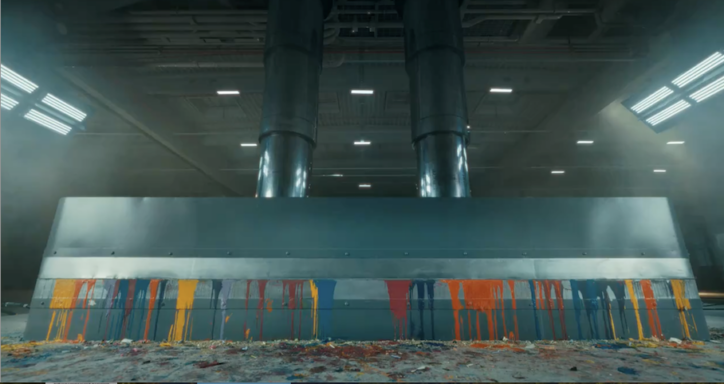Pressed: The Crushing Backlash to Apple’s Destructive Ad
Apple said the quiet part out loud this month.
The company’s punishingly cruel and arrogant new ‘Crush’ ad sparked a firestorm of controversy and criticism from artists, filmmakers, and the general public, forcing Apple to issue a rare apology and pull the ad from television (though CEO Tim Cook has not deleted it from his social media).
The commercial, which promotes the new iPad Pro, features a hydraulic press mercilessly crushing an array of creative tools and objects, from musical instruments to a delicate sculpture. After destroying everything in its wake and as the press lifts, it reveals the sleek, thin form of the iPad — a device that, in Apple’s telling, renders all those old-fashioned tools obsolete.
But for many viewers, the ad’s message wasn’t one of progress or empowerment. Instead, it felt like a brutal attack on the very essence of human creativity — a troubling metaphor for the way that Big Tech’s relentless pursuit of profit and efficiency threatens to steamroll everything that makes us human.

Samsung didn’t miss the opportunity to respond and released a brilliant response to it, an ad called “Uncrushed.”
In this article, we’ll explore the intense backlash to Apple’s ‘Crush’ ad and what it reveals about the growing anxiety and resistance to the unchecked power of artificial intelligence and the tech industry’s assault on artistic labor. We’ll examine the broader cultural context of this controversy and what it means for the future of creativity in an increasingly automated world.
Because make no mistake — this is not just a story about a single misguided ad campaign.
From Liberation to Obliteration: What Was Apple Thinking?
Although the ad may have been intended to showcase the iPad Pro’s versatility and power, it instead struck a discordant note with its unsettling imagery and disregard for the value of traditional creative tools.
The sight of a hydraulic press ruthlessly crushing musical instruments, paintbrushes, cameras, and a delicate sculpture left many viewers appalled, interpreting the ad as a callous celebration of technology’s dominance over human artistry.
In an era where the rapid advancement of artificial intelligence has raised concerns about the displacement of human creators, Apple’s choice to portray the obliteration of traditional artistic tools felt like a slap in the face to those who dedicate their lives to creative pursuits with the very tools the company crushed in the ad.
The backlash to the ad was swift and unequivocal. Editorial pages and social media platforms erupted with criticism from artists, filmmakers, and concerned citizens who found the commercial’s message deeply offensive.
Tripp Mickle, writing for The New York Times, reported that the ad’s critics saw it as “a metaphor for how Big Tech has cashed in on their work by crushing or co-opting the artistic tools that humanity has used for centuries.”
The visceral reactions elicited by the ad were encapsulated by Tech Crunch’s Devin Coldewey, who called it “disgusting” and wrote, “The Apple ad sends the message that the future it wants doesn’t have bottles of paint, dials to turn, sculpture, physical instruments, paper books…If that future doesn’t disgust you, you’re welcome to it.”
Musician Crispin Hunt, as quoted by the BBC, likened the act of destroying musical instruments to the evocative image of burning books, underscoring the ad’s assault on creative expression. Even high-profile figures like actor Hugh Grant weighed in, decrying the ad as “the destruction of the human experience, courtesy of Silicon Valley.”
The outcry was so intense that Apple was forced to issue an apology, with Vice President of Marketing Communications Tor Myhren admitting that the company had “missed the mark” with the video, which is an understatement to say the least. Apple subsequently pulled the ad from TV, but the damage to its reputation among creatives had already been done.
Apple’s mea culpa represented a rare moment of contrition from a company known for its slick marketing and carefully cultivated identity as a champion of creativity and “thinking different” — a long-standing image that only deepened the sense of betrayal for many in the artistic community.
The controversy stood in stark contrast to Apple’s iconic “1984” commercial, which positioned the company as a rebellious force against conformity and oppression. Directed by Ridley Scott and aired during the Super Bowl, the ad depicted a dystopian future where a Big Brother-like figure on a giant screen addresses a sea of gray-clad, conformist drones. Suddenly, a colorful, athletic woman bursts into the room and hurls a sledgehammer at the screen, shattering it and symbolically freeing the masses from the tyranny of uniformity.
The ‘1984’ ad was a powerful statement of Apple’s ethos at the time — a declaration that its technology was a tool for liberation and individual expression, not submission to a monolithic power structure. It resonated with a generation of creatives who saw Apple as an ally in their fight against the status quo.
Fast-forward four decades, and the ‘Crush’ ad seems to invert that message. Instead of a brave individual striking a blow against an oppressive machine, we see a machine ruthlessly crushing the tools of individual expression.
As TV critic and editor Matt Zoller Seitz observed in an excellent writing on RogerEbert.com, “The rebel warrior with the hammer smashing the old order has been superseded by another Big Brother.”
Where the ‘1984’ ad celebrated the power of technology to amplify human potential, the ‘Crush’ ad seems to revel in technology’s power to erase it, ultimately serving as a disturbing reminder of the growing power imbalance between tech giants and the creative communities they claim to empower.

Rage Against the Machine
Of course, the backlash to Apple’s ad cannot be understood in isolation. It is a symptom of a broader cultural anxiety about the disruptive impact of artificial intelligence on creative industries and the role of technology in shaping our relationship with art and culture.
As generative A.I. tools become more sophisticated and accessible, the prospect of machines churning out content at a fraction of the cost and time it takes human creators has raised existential questions about the value and future of artistic labor.
At a deeper level, the ‘Crush’ ad can be seen as a chilling metaphor for the erosion of the material world in favor of a machine-mediated existence. By glorifying the destruction of physical creative tools, Apple seems to be endorsing a future in which human creativity is subsumed by the cold efficiency of digital technology.
This vision of the future is not just aesthetically troubling; it raises profound philosophical and spiritual questions about the nature of reality and our place within it. As we increasingly outsource our creative impulses to algorithms and artificial intelligence, we risk losing touch with the tangible, embodied experiences that make us human.
Beneath the glossy veneer of innovation and progress, the development of artificial intelligence by Big Tech companies is built on a foundation of extraction and enclosure that threatens to undermine the very essence of human creativity.
Big Tech’s brazen daylight heist of the cultural commons (in the form of the uncompensated appropriation of vast troves of human-created content from artwork and music to writing and photography) treats human creativity as raw material to be exploited for profit. Artists and writers find their work reduced to algorithmic data points, their intellectual property stripped away and fed into the machine — and the benefits accrue almost entirely to the tech companies, who can churn out synthetic media cheaply while the creators whose work was appropriated receive nothing (of course there are exceptions like Adobe whose models are trained by artists who receive compensation and have consented to the use of their works to train their models).
This extractive model is a key part of Big Tech’s business strategy, maximizing profits and maintaining monopolistic control over cultural production. As A.I.-generated content floods the market, it devalues human-created works and threatens to force even more artists to surrender their intellectual property to the algorithms.
Big Tech dismisses concerns by claiming A.I. is merely “learning” like any artist inspired by their predecessors. However, this ignores the power imbalance between individual creators and trillion-dollar corporations, not to mention the fundamental difference between machine learning and human creative processes.
When an artist studies the work of a master painter, they are engaging in a deeply personal and transformative act of interpretation and synthesis, drawing on their own unique perspective and experiences to create something new and original. But when an A.I. model ingests that same painting, it is simply breaking it down into data points and patterns to be regurgitated on command, with no understanding of the meaning or context behind the work.
This is the truth of Big Tech’s vision for an A.I. future: a world in which human artists’ creations are reduced to fodder for algorithms, their value stripped away and concentrated in the hands of a few corporate oligarchs. It is a world in which the diversity and depth of human culture are slowly eroded, replaced by a homogenized slurry of machine-generated content designed to maximize engagement and profit.
So while Big Tech companies may cloak their A.I. ambitions in the language of progress and democratization, the reality is far more dystopian — and that reality is precisely what the Apple ‘Crush’ ad inadvertently invokes.
By saying the quiet part out loud, Apple tapped into a vein of deep emotion coursing through this moment of our cultural zeitgeist. Big Tech may like to move fast and break things, but creatives would prefer not to be the things getting broken.

The Limits of Controversy
Despite the intense backlash to the ‘Crush’ ad, it is unlikely to have a lasting impact on Apple’s bottom line. The company’s long-standing reputation and market dominance have weathered countless controversies over the years, and its loyal customer base is unlikely to abandon ship over a single misstep, no matter how big of a misstep.
However, the ad’s reception should serve as a warning to Apple and other tech giants that the public’s tolerance for the unchecked power of A.I. and the devaluation of human creativity is wearing thin. As we move into an increasingly automated future, it is essential that we find ways to harness the potential of technology while preserving the unique qualities that make us human.
As we navigate this new landscape, we must remain vigilant in defending the value and integrity of artistic labor and the reality of the material world.
Only by advocating for the rights of creators can we hope to build a future in which the power of technology is harnessed for the benefit of all, rather than the enrichment of a few. The resilience and enduring importance of human creativity will be the key to ensuring that our shared reality is not crushed beneath the weight of the machine.

